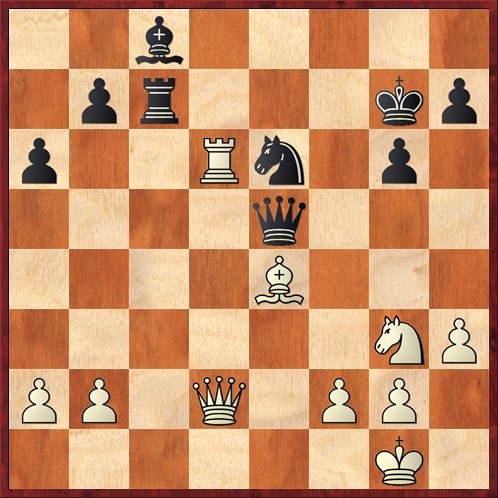After 5 rounds of the Reno Far West Open, the leaders are IMs Steven Zierk and Vladimir Mezentsev. Zierk had been in clear first place after beating Enrico Sevillano in round four to go 4-0. The game had a neat conclusion:
White to move.
As Steven explained to me, Sevillano had sacrificed a pawn earlier for a kingside attack, but White’s kingside was simply too solid and the attack went nowhere. At this point Steven had about 20 minutes left and Sevillano had only 5 minutes to make 6 moves. So Steven decided to complicate things:
35. Bf5! …
The computer says that this is the best move, although by only a small margin. I think that with the opponent in time pressure it’s better than playing a more routine move like 35. Bf3, which the computer also likes.
35. … gf
Maybe Black should have declined the sacrifice? The next few moves are forced.
36. Rd5! …
Surprise! Black’s queen is trapped. After either 36. … Qf6 or 36. … Qf4, 37. Nh5+ forks the king and queen.
36. … Rc1+ 37. Qxc1 Qxd5 38. Qxc8 f4 39. Nh5+ Kg6??
Black had to take the knight, but on 39. … Qxh5 40. Qxe6 White is obviously better. Black’s pawns are scattered and weak, and his king is wide open. Still, it would be a long battle.
40. Qxe6+! resigns
White wins a pawn after 40. … Qxe6 41. Nxf4+ and best of all, the queens come off. Some impressive knight play by the world under-18 champoin!
As for yours truly, well, there’s a reason why I’m writing about Steven Zierk and not about my tournament. Yesterday was one big “fail” for me. I went back to my old habits of getting into time trouble and melting down.
My game against Mezentsev was very interesting. I sacrificed a pawn out of the opening for a position that looked like a “White to play and win” situation. I had two bishops bearing down on Mezentsev’s kingside and it looked as if either Bxh7+ or Bxg7 was going to come at some point. But I couldn’t quite find the right setup of my pieces, and when I finally played the sacrifice Bxg7 it was probably not quite sound. He found a way to trade down to an exchange-up endgame, and by this time I was in completely ridiculous time pressure — something like 10 moves in 1 minute, or 10 moves in 2 minutes. Not surprisingly, I walked into a checkmate trap.
Man, I wish I could have that game back again. If I can figure out what was going on, I may blog about the game or do a ChessLecture about it some other time.
The evening round was more of the same. I won’t bore you with the details, but I had a great position and botched it, then I got into time trouble and that as usual made a bad deal worse.
This morning I settled down and got back into my new, patient, non-time-wasting mindset. I ended up with a draw as Black against Theodore Biyiasis in my favorite Bird’s Variation of the Ruy Lopez. Theodore was very familiar with it, because he had played me once before and also read my blog posts about it. He took a very sensible approach, just developing his pieces efficiently. It’s one of those situations where White can’t possibly be worse, but he was not able to find any way to break through. It was also a nice example of how Black’s doubled pawns at d4 and d5 can actually be an asset. They’re “square eaters,” taking away lots of good squares fro White’s pieces.
So after five rounds, I stand at 2½-2½. I suppose I may still be in the running for an expert prize if I win in the last round, but more than that I just want to follow my pre-tournament plan: be patient, avoid obvious blunders, stay out of time trouble and follow the Poker Theory of Chess (discussed in my last entry).



